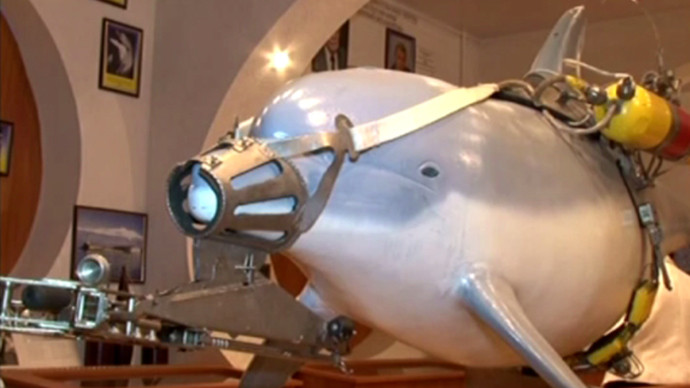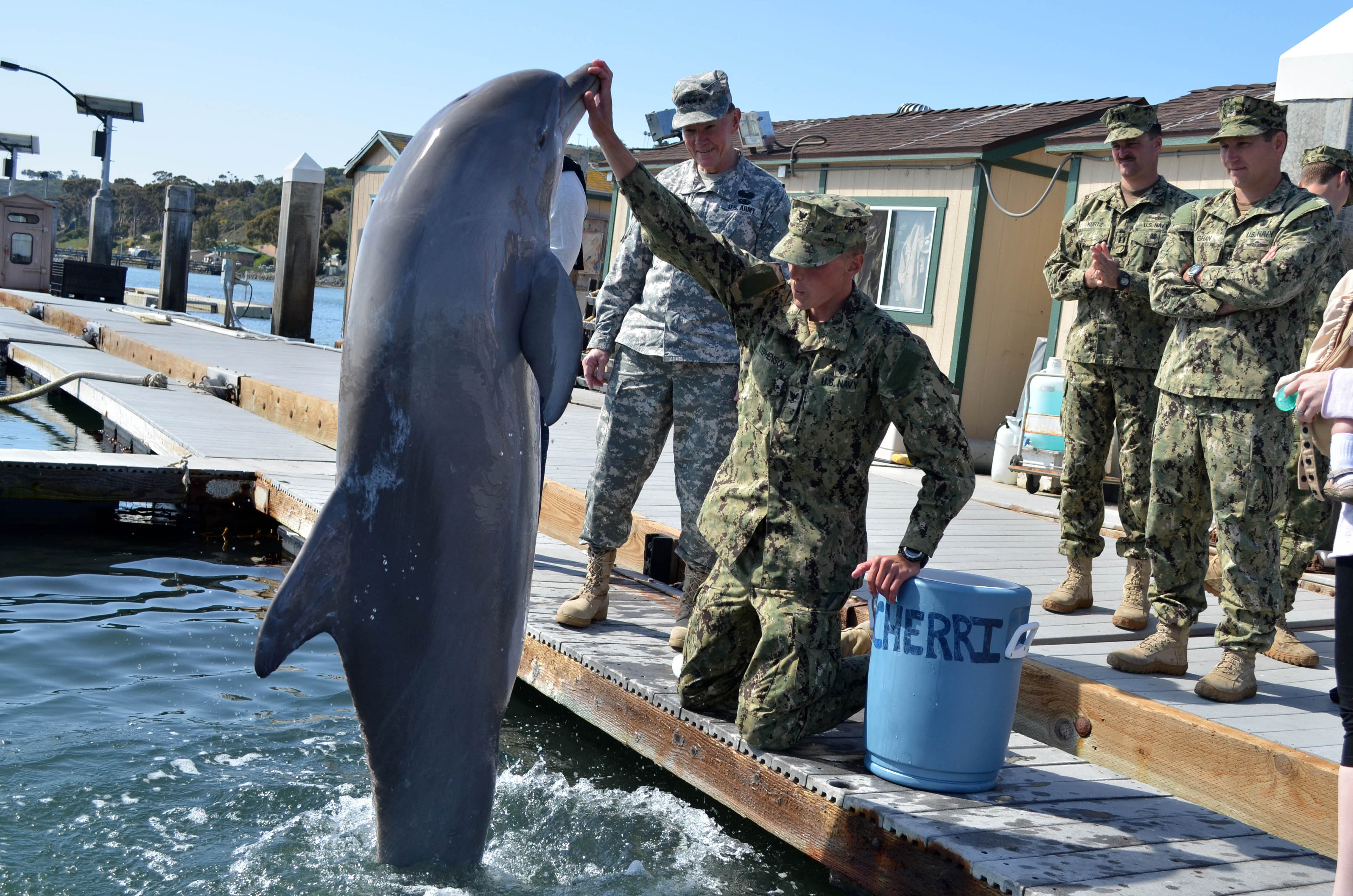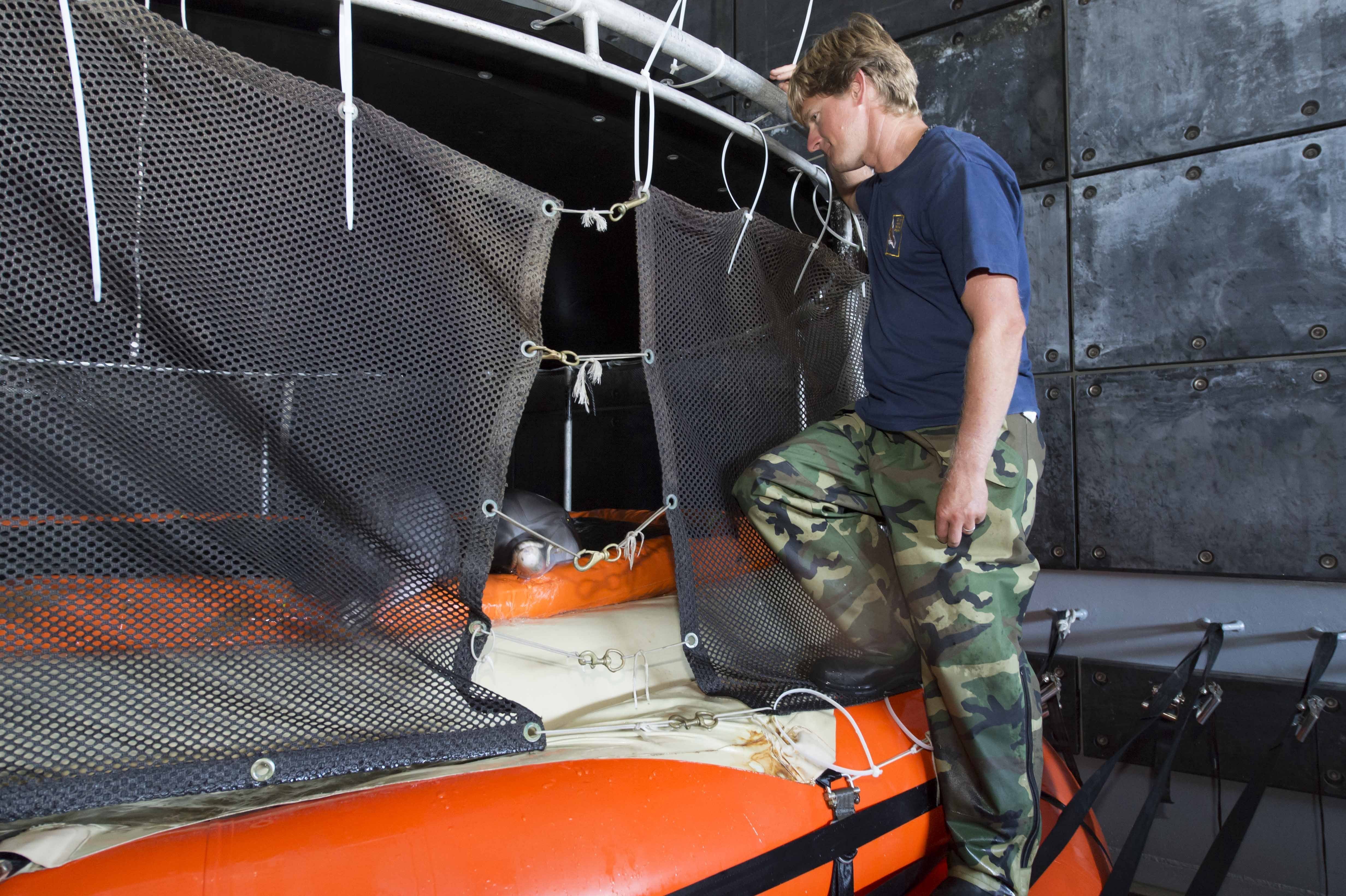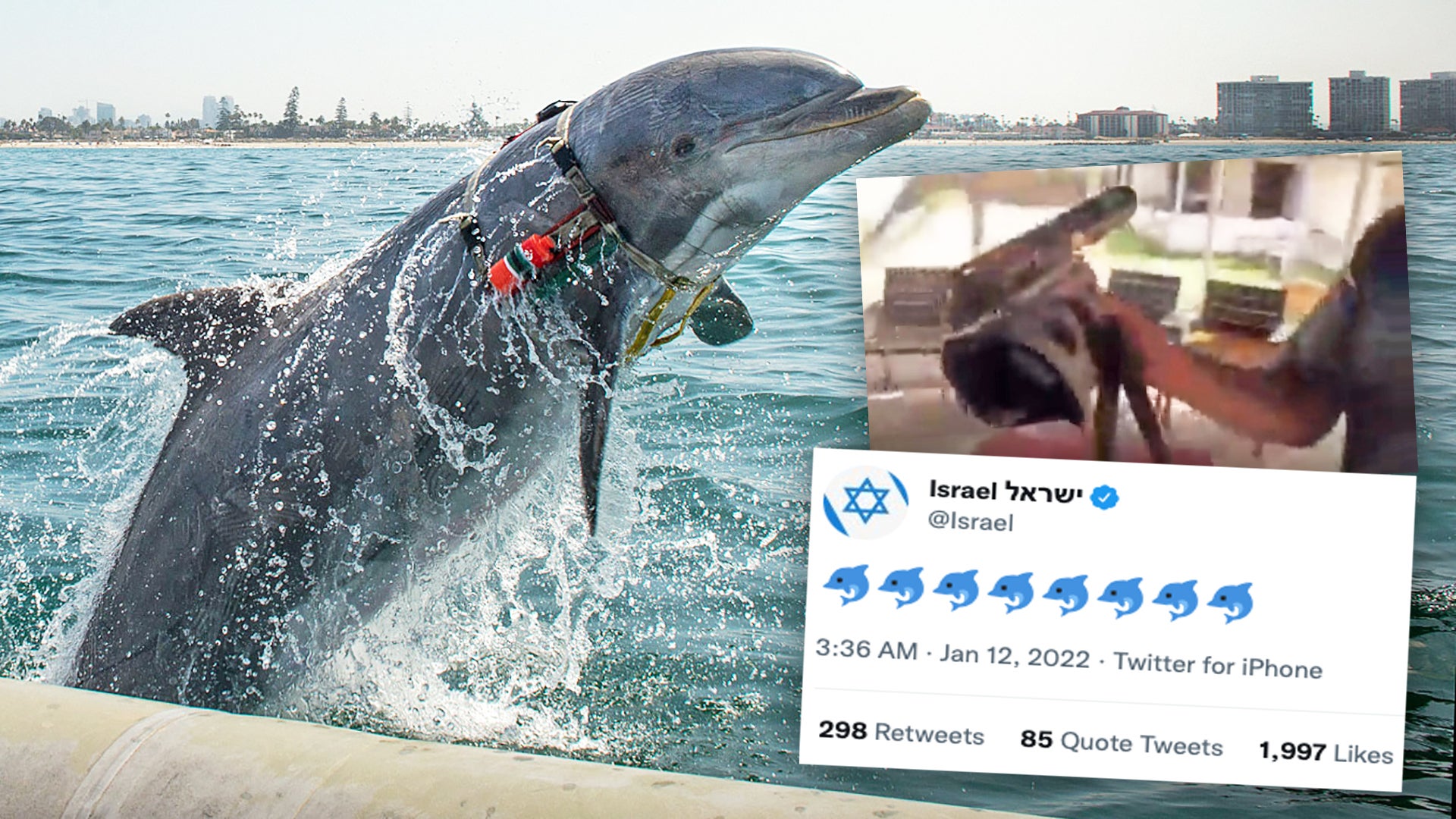Palestinian militant group Hamas claims to have captured an Israeli-trained dolphin armed with a weapon of some kind after it killed one of its members. Hamas has provided limited evidence to support this assertion, but the use of marine mammals to support military and intelligence-gathering activities is certainly well-documented. At the same time, there has been a litany of unsubstantiated reports over the past two decades or so about Israel using a variety of animals, at sea and on land, as well as birds to carry out clandestine missions against its opponents.
It’s not clear when the purported incident in question occurred, but a video clip regarding it first began making the rounds on social media yesterday. The clip is reportedly a segment that had appeared recently on Al Quds TV, a Palestinian television station based in Lebanon and with strong ties to Hamas. At one point in the footage, an individual is seen holding what is alleged to be a nose harness taken from the captured Israeli dolphin. Hamas claims that a member of its frogman unit “who was killed by Israel during the May conflict” discovered the killer dolphin. The animal itself is not seen.

Some sort of cylindrical device can be seen on the harness, although it is unclear exactly what it might be. H.I. Sutton, an expert on undersea warfare, has suggested that this might be a speargun-like weapon, or perhaps a system designed to attach a buoy of some kind to targets.
The harness itself does have a general appearance that is reminiscent of ones used on dolphins as part of known military marine mammal programs, such as those run by the United States and Russia. Neither the Israel Defense Forces nor Mossad, the country’s main intelligence agency, have a publicly acknowledged program like this, but there have been numerous, if often unsubstantiated, accusations over the years about Israeli-training marine mammals performing specialized missions.


No further information appears to have surfaced to corroborate Hamas’ claims in this particular case. This group is among those who have asserted they have been targeted by Israeli dolphins, specifically, in the past.
Dolphins, which are extremely intelligent animals and can be trained to spot, mark, and even recover objects of interest, could easily be among the assets supporting Israel’s activities against Hamas and other Palestinian military groups in the Gaza Strip. Hamas is known to have various underwater capabilities, including combat divers and explosive-laden remote-controlled unmanned underwater vehicles. These capabilities were among those that Israeli forces targeted during a burst of fighting with Palestinians in the Gaza Strip last summer.
Unarmed dolphins could be used for various reconnaissance and security missions, ranging from port security to helping hunt for Hamas frogmen, mines, and other hazards. Israel maintains a virtual blockade around the Gaza Strip, as well, meaning that dolphins might be valuable when trying to target smuggling operations in and out of the area.
A dolphin with some kind of speargun-type or some other kind of piercing weapon could certainly be trained to try to stab an enemy diver, though there’s no indication that they would be able to “tell friend-or-foe,” H.I. Sutton pointed out on his website. Israeli authorities might consider this an acceptable risk when employed in areas where only Hamas members are expected to be swimming. Of course, just being hit by a dolphin underwater, especially at night, when militants might be inclined to operate, could be disorienting and dangerous in its own right. It’s also possible the nose harness seen in the Hamas footage could be used for attaching strobes to enemy divers, similar to systems the US Navy has previously tested.

Whether or not Israel has ever used dolphins for anti-diver security or any other operations is unknown. However, there is an extensive precedent for military forces around the world to use dolphins and marine mammals for exactly these purposes.
The Soviet Union had its own marine mammal program based in the Black Sea during the Cold War. The program came under Ukrainian control after the fall of the USSR, then returned to Russian control after Russia’s seizure of the Crimea Region in 2014. Those dolphins would go on to die under Russian care after they reportedly refused to cooperate with their new handlers or eat.
The Russian Navy appears to still have an active marine mammal program, according to an analysis of satellite imagery of Syria taken in 2018. Forbes reported in 2020 that these images show pens in a Russian-Navy controlled harbor that housed marine mammals which “would likely be used to counter enemy divers who might try to sabotage ships in the port” or perform equipment recovery roles or intelligence missions.
When a Beluga whale wearing a harness of some kind was spotted in Norway’s far north Finnmark region in 2019, there was speculation that it may have escaped or been freed from a Russian or former Soviet program. Belugas were in fact studied for use by both the Soviet Union and the United States Navy, but there was never conclusive evidence that the Beluga found in Norway belonged to that former Soviet program.

The U.S. Navy’s Marine Mammal Program also trains dolphins and sea lions for various roles including equipment recovery, explosives detection, or detecting and apprehending swimmers and divers that aren’t authorized to approach Naval vessels or facilities. The program, which began in the 1960s and continues to this day, trains U.S. Navy Marine Mammal Teams that can be deployed to any location in the world in 72 hours with a combination of helicopters and fixed-wing aircraft. Whether or not the mammals deployed by these teams wear specialized dart gun harnesses or other gear remains a mystery, as none has been officially disclosed.

A more ambitious Cold War project saw the U.S. Navy attempt to emulate and employ whale songs as a secret code for long-distance underwater communication. While the effort did have some success, it’s unclear what became of the program, but DARPA is currently pursuing a program to use living aquatic animals as sensors that might be able to alert the Navy of any changes to undersea conditions such as a passing submarine or sensor placed on the seafloor.
There have also been persistent rumors about a U.S. program to arm dolphins with poison darts, but no such program has ever been confirmed. Michael Greenwood, a former Navy dolphin trainer, has said the mammals were armed with “large hypodermic syringes” that could kill enemy divers. Those claims have never been substantiated. The conspiracy theories about dart-firing dolphins are so prevalent, in fact, that the Naval Information Warfare Center Pacific in San Diego, California even has a section on its Marine Mammal Program page titled “Why have there been so many rumors about the program?” which explains a few reasons for the rumors:
Several decades of classification of the program’s true missions led to media speculation and animal activist charges of dolphins used as offensive weapons—claims that could not be countered due to that classification. A popular movie in 1973 (“The Day of the Dolphin”) reinforced those ideas. Since [the] declassification of the program in the early 1990s, the Navy has repeatedly and openly shared the story of its marine mammals and their missions in the media, but rumors are not easily forgotten, and there are those few who continue to actively promote them.
In 2007, the Public Affairs Officer for the Space and Naval Warfare Systems Center (SPAWAR) spoke to Wired and explained what these teams actually do in the field, clarifying that the Navy’s dolphins are trained simply to patrol harbors or ports for unauthorized swimmers or divers and ring a bell on the side of their handlers’ boats when any are encountered. “The security forces handle the situation from there,” the SPAWAR spokesperson said.

There is some evidence of the Soviets at least experimenting with armed marine mammals, leading to similar claims about dolphins armed with specialized dart guns that fire whenever the animals nudge targets with their noses.
The various rumors and conspiracy theories about weaponized marine mammals are often fueled by the misidentification of animals tagged for scientific purposes or even outright hoaxes. It’s possible the recent Hamas claims fall under this umbrella, but with so little to go on, it’s hard to say exactly what we’re seeing in the footage that circulated online this week.
This is not the first time Hamas has made claims about militarized Israeli dolphins. In 2015, the Palestinian newspaper Al Quds claimed that Hamas had captured a dolphin that was caught wearing a camera and an underwater monitoring device capable of firing small projectiles. Conspiracy theories about Israel’s alleged animal spies have been circulating for years, ranging from attack sharks being released off the coast of Egypt to migratory birds being fitted with intelligence-gathering microchips.
Iran has made similar colorful claims in the past, “arresting” over a dozen squirrels alleged to be Iranian spies in 2007 and two pigeons in 2008 with the same charges. An Iranian senior military advisor told reporters in 2018 that specialized lizards whose skin could “attract atomic waves” were being used to spy on the nation’s nuclear program.
None of these theories has yet to be proven true in any way. Israeli forces have previously faced remote-controlled underwater improvised explosive devices said to be operated by Hamas, so it’s not entirely impossible that the Israeli may have sought dolphins to protect naval assets. However, there appears to be no hard evidence that the Israel Defense Forces (IDF) has ever pursued a marine mammal program.
For their part, the state of Israel’s official Twitter account seemed to poke fun at Hamas’ allegations, tweeting out a string of eight dolphin emojis the day after the footage of the supposed dolphin harness surfaced.
For now, the story of the killer Israeli dolphin reportedly caught by Hamas remains possible, but that’s about it. It also could be just the latest chapter in a long history of similar claims made about Israeli’s supposed animal spies and assassins.
Contact the author: Brett@thedrive.com
